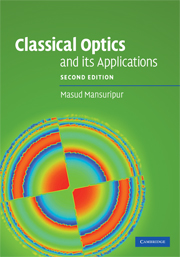Book contents
- Frontmatter
- Contents
- Preface to the second English edition
- Preface to the first edition
- Introduction
- 1 Abbe's sine condition
- 2 Fourier optics
- 3 Effect of polarization on diffraction in systems of high numerical aperture
- 4 Gaussian beam optics
- 5 Coherent and incoherent imaging
- 6 First-order temporal coherence in classical optics
- 7 The van Cittert–Zernike theorem
- 8 Partial polarization, Stokes parameters, and the Poincaré sphere
- 9 Second-order coherence and the Hanbury Brown–Twiss experiment
- 10 What in the world are surface plasmons?
- 11 Surface plasmon polaritons on metallic surfaces
- 12 The Faraday effect
- 13 The magneto-optical Kerr effect
- 14 The Sagnac interferometer
- 15 Fabry–Pérot etalons in polarized light
- 16 The Ewald–Oseen extinction theorem
- 17 Reciprocity in classical linear optics
- 18 Optical pulse compression
- 19 The uncertainty principle in classical optics
- 20 Omni-directional dielectric mirrors
- 21 Linear optical vortices
- 22 Geometric-optical rays, Poynting's vector, and the field momenta
- 23 Doppler shift, stellar aberration, and convection of light by moving media
- 24 Diffraction gratings
- 25 Diffractive optical elements
- 26 The Talbot effect
- 27 Some quirks of total internal reflection
- 28 Evanescent coupling
- 29 Internal and external conical refraction
- 30 Transmission of light through small elliptical apertures
- 31 The method of Fox and Li
- 32 The beam propagation method
- 33 Launching light into a fiber
- 34 The optics of semiconductor diode lasers
- 35 Michelson's stellar interferometer
- 36 Bracewell's interferometric telescope
- 37 Scanning optical microscopy
- 38 Zernike's method of phase contrast
- 39 Polarization microscopy
- 40 Nomarski's differential interference contrast microscope
- 41 The van Leeuwenhoek microscope
- 42 Projection photolithography
- 43 Interaction of light with subwavelength structures
- 44 The Ronchi test
- 45 The Shack–Hartmann wavefront sensor
- 46 Ellipsometry
- 47 Holography and holographic interferometry
- 48 Self-focusing in nonlinear optical media
- 49 Spatial optical solitons
- 50 Laser heating of multilayer stacks
- Index
- References
43 - Interaction of light with subwavelength structures
Published online by Cambridge University Press: 31 January 2011
- Frontmatter
- Contents
- Preface to the second English edition
- Preface to the first edition
- Introduction
- 1 Abbe's sine condition
- 2 Fourier optics
- 3 Effect of polarization on diffraction in systems of high numerical aperture
- 4 Gaussian beam optics
- 5 Coherent and incoherent imaging
- 6 First-order temporal coherence in classical optics
- 7 The van Cittert–Zernike theorem
- 8 Partial polarization, Stokes parameters, and the Poincaré sphere
- 9 Second-order coherence and the Hanbury Brown–Twiss experiment
- 10 What in the world are surface plasmons?
- 11 Surface plasmon polaritons on metallic surfaces
- 12 The Faraday effect
- 13 The magneto-optical Kerr effect
- 14 The Sagnac interferometer
- 15 Fabry–Pérot etalons in polarized light
- 16 The Ewald–Oseen extinction theorem
- 17 Reciprocity in classical linear optics
- 18 Optical pulse compression
- 19 The uncertainty principle in classical optics
- 20 Omni-directional dielectric mirrors
- 21 Linear optical vortices
- 22 Geometric-optical rays, Poynting's vector, and the field momenta
- 23 Doppler shift, stellar aberration, and convection of light by moving media
- 24 Diffraction gratings
- 25 Diffractive optical elements
- 26 The Talbot effect
- 27 Some quirks of total internal reflection
- 28 Evanescent coupling
- 29 Internal and external conical refraction
- 30 Transmission of light through small elliptical apertures
- 31 The method of Fox and Li
- 32 The beam propagation method
- 33 Launching light into a fiber
- 34 The optics of semiconductor diode lasers
- 35 Michelson's stellar interferometer
- 36 Bracewell's interferometric telescope
- 37 Scanning optical microscopy
- 38 Zernike's method of phase contrast
- 39 Polarization microscopy
- 40 Nomarski's differential interference contrast microscope
- 41 The van Leeuwenhoek microscope
- 42 Projection photolithography
- 43 Interaction of light with subwavelength structures
- 44 The Ronchi test
- 45 The Shack–Hartmann wavefront sensor
- 46 Ellipsometry
- 47 Holography and holographic interferometry
- 48 Self-focusing in nonlinear optical media
- 49 Spatial optical solitons
- 50 Laser heating of multilayer stacks
- Index
- References
Summary
When a light field interacts with structures that have complex geometric features comparable in size to the wavelength of the light, it is not permissible to invoke the assumptions of the classical diffraction theory, which simplify the problem and allow for approximate solutions. For such cases, direct numerical solutions of the governing equations are sought through approximating the continuous time and space derivatives by the appropriate difference operators. The Finite Difference Time Domain (FDTD) method discretizes Maxwell's equations by using a central difference operator in both the time and space variables. The E- and B-fields are then represented by their discrete values on the spatial grid, and are advanced in time in steps of Δt. The numerical solution thus obtained to Maxwell's equations (in conjunction with the relevant constitutive relations) provides a highly reliable representation of the electromagnetic field distribution in the space-time region under consideration.
This chapter presents examples of application of the FDTD method to problems involving the interaction between a focused beam of light and certain subwavelength structures of practical interest. A few general remarks concerning the nature of the FDTD method appear in the next section. This is followed by a description of the simulated system and two examples in which comparison is possible between the FDTD method and an alternative method of calculation. We then present simulation results for the case of a focused beam interacting with small pits and apertures in a thin film supported by a transparent substrate.
- Type
- Chapter
- Information
- Classical Optics and its Applications , pp. 599 - 613Publisher: Cambridge University PressPrint publication year: 2009
References
- 1
- Cited by



